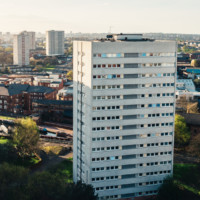Editor's Pick
Developers warned of further action as just third of high rises remove cladding

Progress has been made with remediation work but more needs to be done
Some 64 of the 214 high rise private sector buildings identified as having unsafe aluminium composite material (ACM) cladding have been completely remediated as of 31 December.
This accounts for 4,900 to 5,900 dwellings and leaves 150 properties over 18 metres yet to complete construction.
Of these, 112 buildings have begun the process while 38 have not started.
Lord Greenhalgh, building safety minister, said the few that had not started works were “unacceptable” and cautioned further action if plans to do so did not begin soon.
Five of the buildings which have not begun remediation are known to be unoccupied, while the remaining 145 account for 12,200 to 14,600 occupied dwellings.
The social sector has been quicker to make properties safer with all 156 high rise buildings having started or completed the removal of ACM cladding.
In total, 462 high rise buildings in England have been identified as having ACM cladding and 11 more are awaiting further tests.
Although a Private Sector Remediation Fund of £200m was made available to developers and freeholders to assist with the removal of unsafe materials from high rise buildings over 18 metres, half of the works are being paid for by building owners or other funding solutions.
Developers or freeholders have committed to paying for 87 buildings while 21 have been accepted under a warranty claim.
Some 100 buildings were in scope for the fund with 94 submitting an application and 64 approved for the funding of full costs. So far, £151m has been provided through the Private Sector Remediation Fund.
As at 31 December 2020, 240 buildings had their remediation funded by government, with the social sector receiving money to correct 140 of the 156 buildings identified.
Robert Jenrick, housing secretary, said: “Today’s stats show that – despite the pandemic – significant progress has continued to have been made with remediation work either complete or on site on around 95 per cent of buildings, rising to 100 per cent in all social or student high rise buildings.
“This is a big step forwards. While there is still more to do, we are helping make the highest risk buildings with dangerous cladding safer, more quickly.”
Lord Greenhalgh, building safety minister, added: “Building owners are responsible for making sure that their buildings, and the people who live in them, are safe. However, some need to do more and it’s unacceptable a minority are yet to start work.
“We are in contact with the remaining buildings where remediation has not started and we are clear if work does not take place urgently we will take further enforcement action.”